check transmission fluid LINCOLN AVIATOR 2004 Owners Manual
[x] Cancel search | Manufacturer: LINCOLN, Model Year: 2004, Model line: AVIATOR, Model: LINCOLN AVIATOR 2004Pages: 336, PDF Size: 3.69 MB
Page 127 of 336
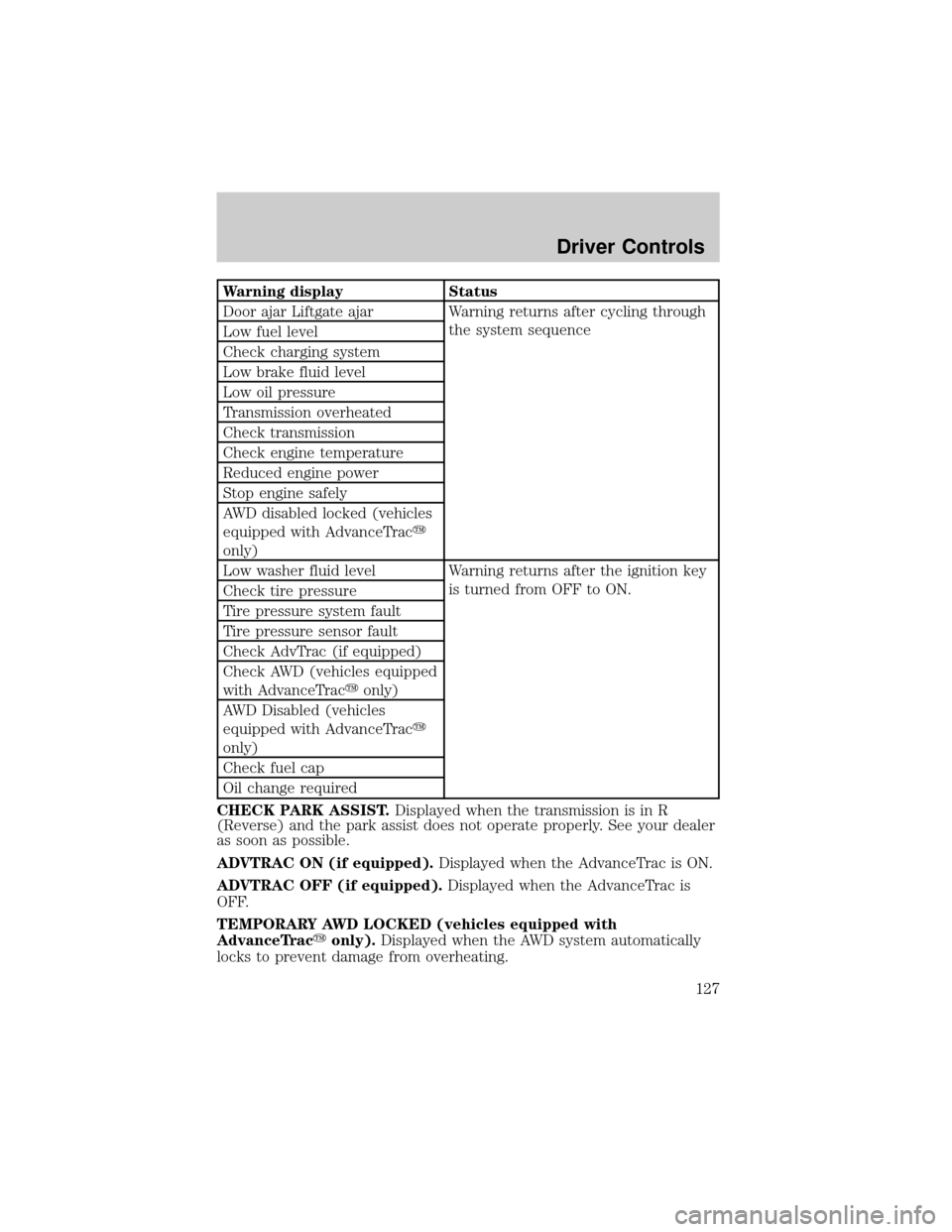
Warning display Status
Door ajar Liftgate ajar Warning returns after cycling through
the system sequence
Low fuel level
Check charging system
Low brake fluid level
Low oil pressure
Transmission overheated
Check transmission
Check engine temperature
Reduced engine power
Stop engine safely
AWD disabled locked (vehicles
equipped with AdvanceTracy
only)
Low washer fluid level Warning returns after the ignition key
is turned from OFF to ON.
Check tire pressure
Tire pressure system fault
Tire pressure sensor fault
Check AdvTrac (if equipped)
Check AWD (vehicles equipped
with AdvanceTracyonly)
AWD Disabled (vehicles
equipped with AdvanceTracy
only)
Check fuel cap
Oil change required
CHECK PARK ASSIST.Displayed when the transmission is in R
(Reverse) and the park assist does not operate properly. See your dealer
as soon as possible.
ADVTRAC ON (if equipped).Displayed when the AdvanceTrac is ON.
ADVTRAC OFF (if equipped).Displayed when the AdvanceTrac is
OFF.
TEMPORARY AWD LOCKED (vehicles equipped with
AdvanceTracyonly).Displayed when the AWD system automatically
locks to prevent damage from overheating.
Driver Controls
127
Page 129 of 336
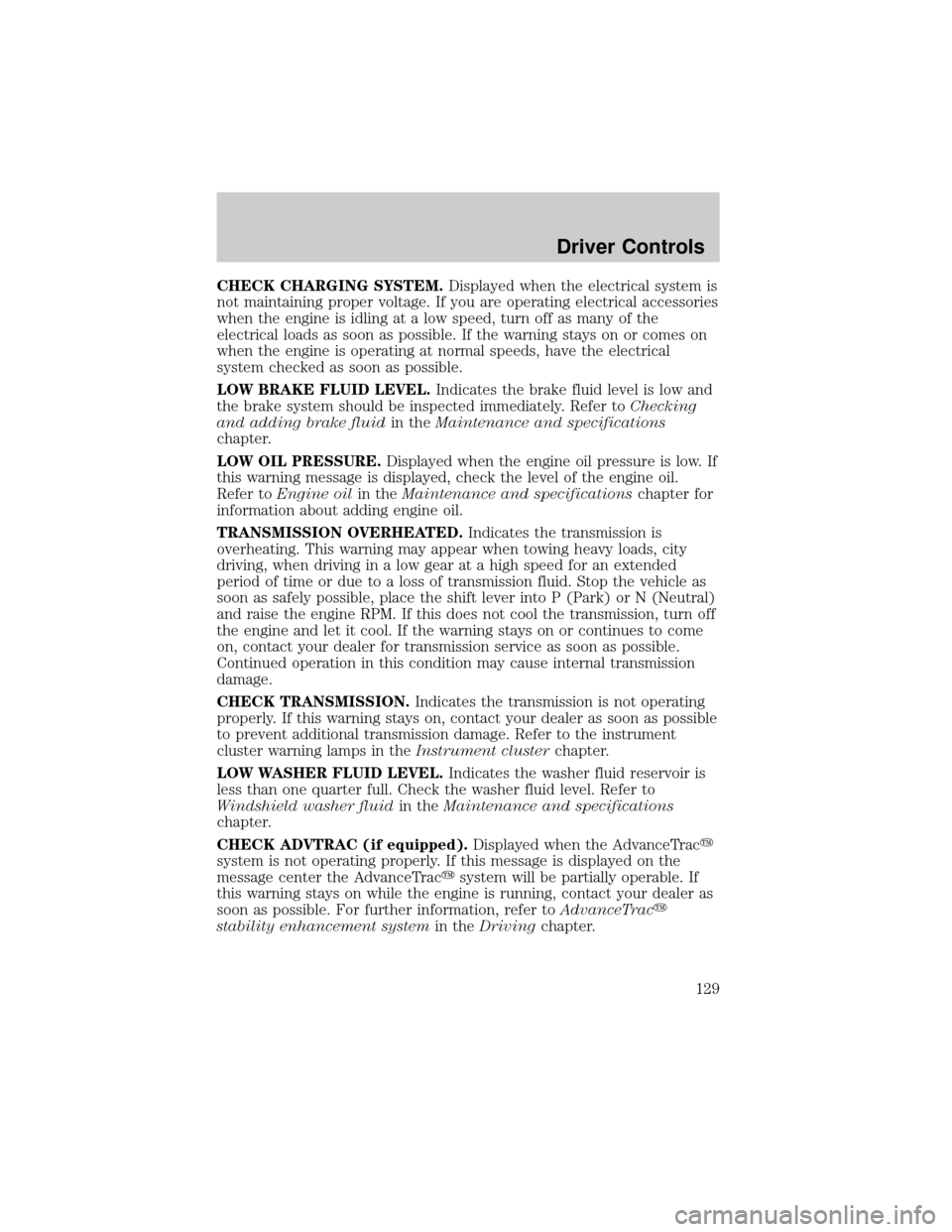
CHECK CHARGING SYSTEM.Displayed when the electrical system is
not maintaining proper voltage. If you are operating electrical accessories
when the engine is idling at a low speed, turn off as many of the
electrical loads as soon as possible. If the warning stays on or comes on
when the engine is operating at normal speeds, have the electrical
system checked as soon as possible.
LOW BRAKE FLUID LEVEL.Indicates the brake fluid level is low and
the brake system should be inspected immediately. Refer toChecking
and adding brake fluidin theMaintenance and specifications
chapter.
LOW OIL PRESSURE.Displayed when the engine oil pressure is low. If
this warning message is displayed, check the level of the engine oil.
Refer toEngine oilin theMaintenance and specificationschapter for
information about adding engine oil.
TRANSMISSION OVERHEATED.Indicates the transmission is
overheating. This warning may appear when towing heavy loads, city
driving, when driving in a low gear at a high speed for an extended
period of time or due to a loss of transmission fluid. Stop the vehicle as
soon as safely possible, place the shift lever into P (Park) or N (Neutral)
and raise the engine RPM. If this does not cool the transmission, turn off
the engine and let it cool. If the warning stays on or continues to come
on, contact your dealer for transmission service as soon as possible.
Continued operation in this condition may cause internal transmission
damage.
CHECK TRANSMISSION.Indicates the transmission is not operating
properly. If this warning stays on, contact your dealer as soon as possible
to prevent additional transmission damage. Refer to the instrument
cluster warning lamps in theInstrument clusterchapter.
LOW WASHER FLUID LEVEL.Indicates the washer fluid reservoir is
less than one quarter full. Check the washer fluid level. Refer to
Windshield washer fluidin theMaintenance and specifications
chapter.
CHECK ADVTRAC (if equipped).Displayed when the AdvanceTracy
system is not operating properly. If this message is displayed on the
message center the AdvanceTracysystem will be partially operable. If
this warning stays on while the engine is running, contact your dealer as
soon as possible. For further information, refer toAdvanceTracy
stability enhancement systemin theDrivingchapter.
Driver Controls
129
Page 216 of 336
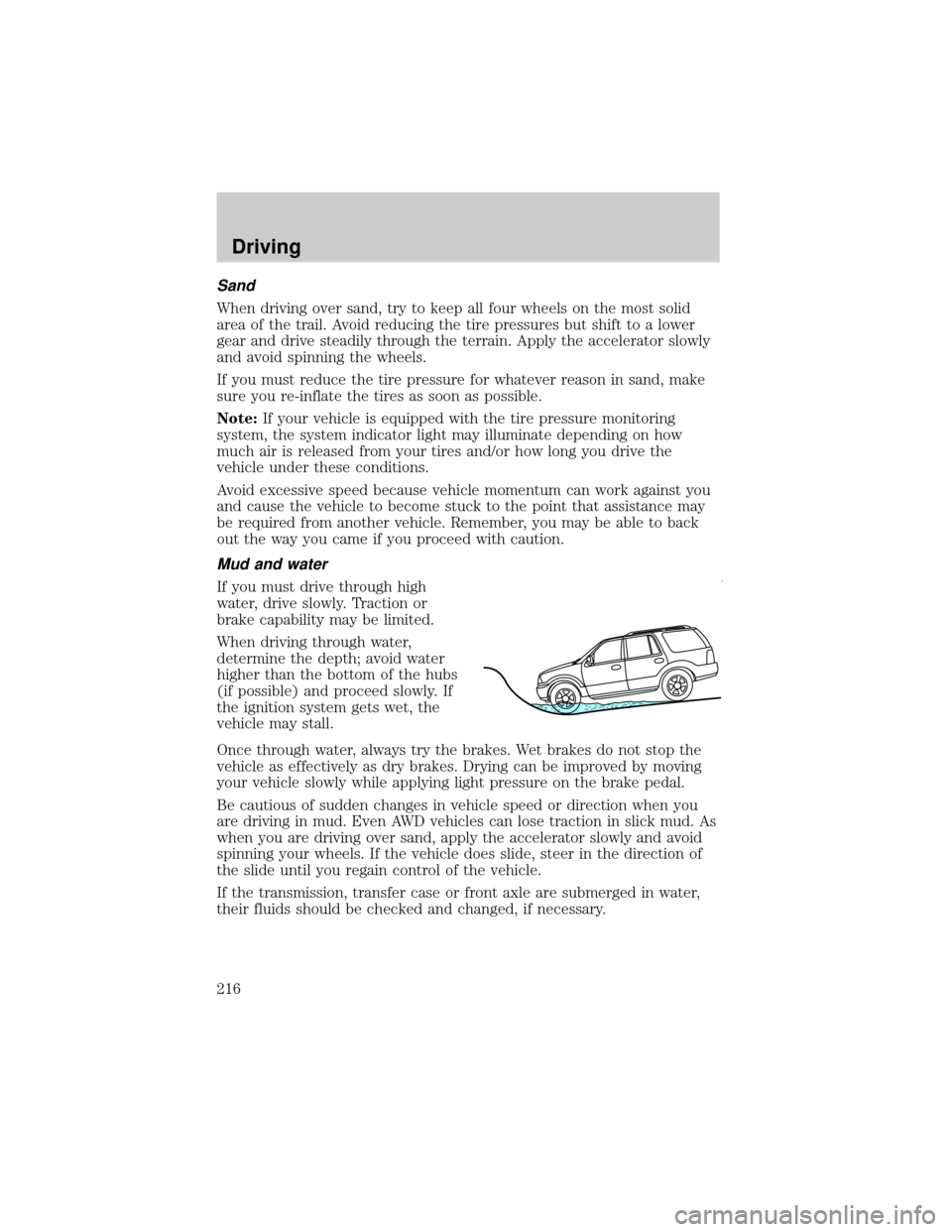
Sand
When driving over sand, try to keep all four wheels on the most solid
area of the trail. Avoid reducing the tire pressures but shift to a lower
gear and drive steadily through the terrain. Apply the accelerator slowly
and avoid spinning the wheels.
If you must reduce the tire pressure for whatever reason in sand, make
sure you re-inflate the tires as soon as possible.
Note:If your vehicle is equipped with the tire pressure monitoring
system, the system indicator light may illuminate depending on how
much air is released from your tires and/or how long you drive the
vehicle under these conditions.
Avoid excessive speed because vehicle momentum can work against you
and cause the vehicle to become stuck to the point that assistance may
be required from another vehicle. Remember, you may be able to back
out the way you came if you proceed with caution.
Mud and water
If you must drive through high
water, drive slowly. Traction or
brake capability may be limited.
When driving through water,
determine the depth; avoid water
higher than the bottom of the hubs
(if possible) and proceed slowly. If
the ignition system gets wet, the
vehicle may stall.
Once through water, always try the brakes. Wet brakes do not stop the
vehicle as effectively as dry brakes. Drying can be improved by moving
your vehicle slowly while applying light pressure on the brake pedal.
Be cautious of sudden changes in vehicle speed or direction when you
are driving in mud. Even AWD vehicles can lose traction in slick mud. As
when you are driving over sand, apply the accelerator slowly and avoid
spinning your wheels. If the vehicle does slide, steer in the direction of
the slide until you regain control of the vehicle.
If the transmission, transfer case or front axle are submerged in water,
their fluids should be checked and changed, if necessary.
Driving
216
Page 221 of 336
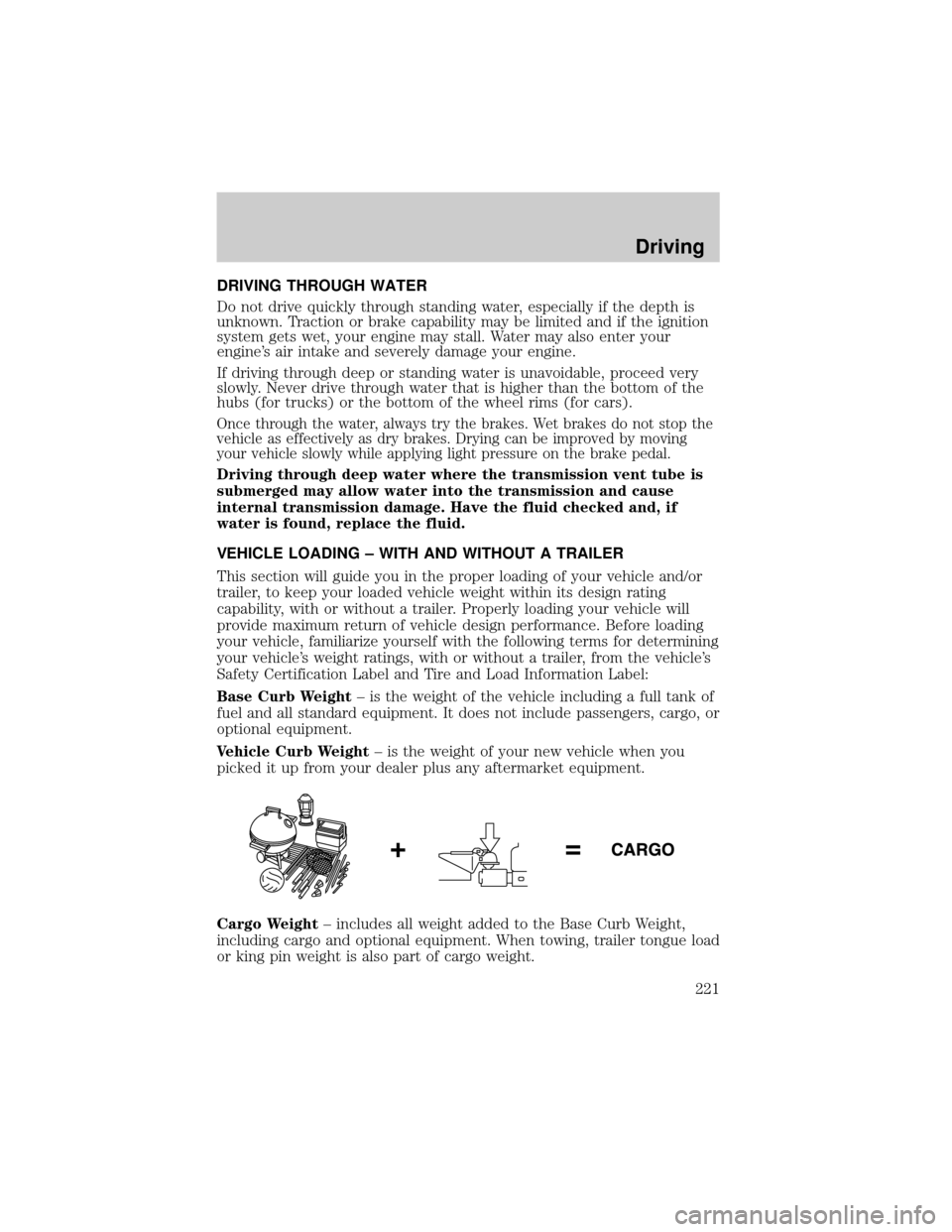
DRIVING THROUGH WATER
Do not drive quickly through standing water, especially if the depth is
unknown. Traction or brake capability may be limited and if the ignition
system gets wet, your engine may stall. Water may also enter your
engine's air intake and severely damage your engine.
If driving through deep or standing water is unavoidable, proceed very
slowly. Never drive through water that is higher than the bottom of the
hubs (for trucks) or the bottom of the wheel rims (for cars).
Once through the water, always try the brakes. Wet brakes do not stop the
vehicle as effectively as dry brakes. Drying can be improved by moving
your vehicle slowly while applying light pressure on the brake pedal.
Driving through deep water where the transmission vent tube is
submerged may allow water into the transmission and cause
internal transmission damage. Have the fluid checked and, if
water is found, replace the fluid.
VEHICLE LOADING ± WITH AND WITHOUT A TRAILER
This section will guide you in the proper loading of your vehicle and/or
trailer, to keep your loaded vehicle weight within its design rating
capability, with or without a trailer. Properly loading your vehicle will
provide maximum return of vehicle design performance. Before loading
your vehicle, familiarize yourself with the following terms for determining
your vehicle's weight ratings, with or without a trailer, from the vehicle's
Safety Certification Label and Tire and Load Information Label:
Base Curb Weight± is the weight of the vehicle including a full tank of
fuel and all standard equipment. It does not include passengers, cargo, or
optional equipment.
Vehicle Curb Weight± is the weight of your new vehicle when you
picked it up from your dealer plus any aftermarket equipment.
Cargo Weight± includes all weight added to the Base Curb Weight,
including cargo and optional equipment. When towing, trailer tongue load
or king pin weight is also part of cargo weight.
Driving
221
Page 230 of 336

Launching or retrieving a boat
Disconnect the wiring to the trailer before backing the trailer
into the water. Reconnect the wiring to the trailer after the
trailer is removed from the water.
When backing down a ramp during boat launching or retrieval:
²do not allow the static water level to rise above the bottom edge of
the rear bumper.
²do not allow waves to break higher than 15 cm (6 inches) above the
bottom edge of the rear bumper.
Exceeding these limits may allow water to enter vehicle components:
²causing internal damage to the components.
²affecting driveability, emissions and reliability.
Replace the rear axle lubricant any time the axle has been submerged in
water. Rear axle lubricant quantities are not to be checked or changed
unless a leak is suspected or repair required.
RECREATIONAL TOWING (ALL WHEELS ON THE GROUND)
Follow these guidelines for your specific powertrain combination to tow
your vehicle with all four wheels on the ground (such as behind a
recreational vehicle).
These guidelines are designed to ensure that your transmission is not
damaged due to insufficient lubrication.
Rear Wheel Drive (RWD) 4x2 vehicles:
This applies to all 4x2 trucks/sport utilities with rear wheel drive capability.
²Place the transmission in N (Neutral).
²Maximum speed is 56 km/h (35 mph).
²Maximum distance is 80 km (50 miles).
If a distance of 80 km (50 miles) or a speed of 56 km/h (35 mph) must
be exceeded, you must disconnect the driveshaft. Ford recommends the
driveshaft be removed/installed only by a qualified technician. See your
local dealer for driveshaft removal/installation.
Improper removal/installation of the driveshaft can cause
transmission fluid loss, damage to the driveshaft and internal
transmission components.
AWD vehicles:
Vehicles equipped with AWD cannot be towed with any wheels on the
ground as vehicle damage may occur.
Driving
230
Page 296 of 336
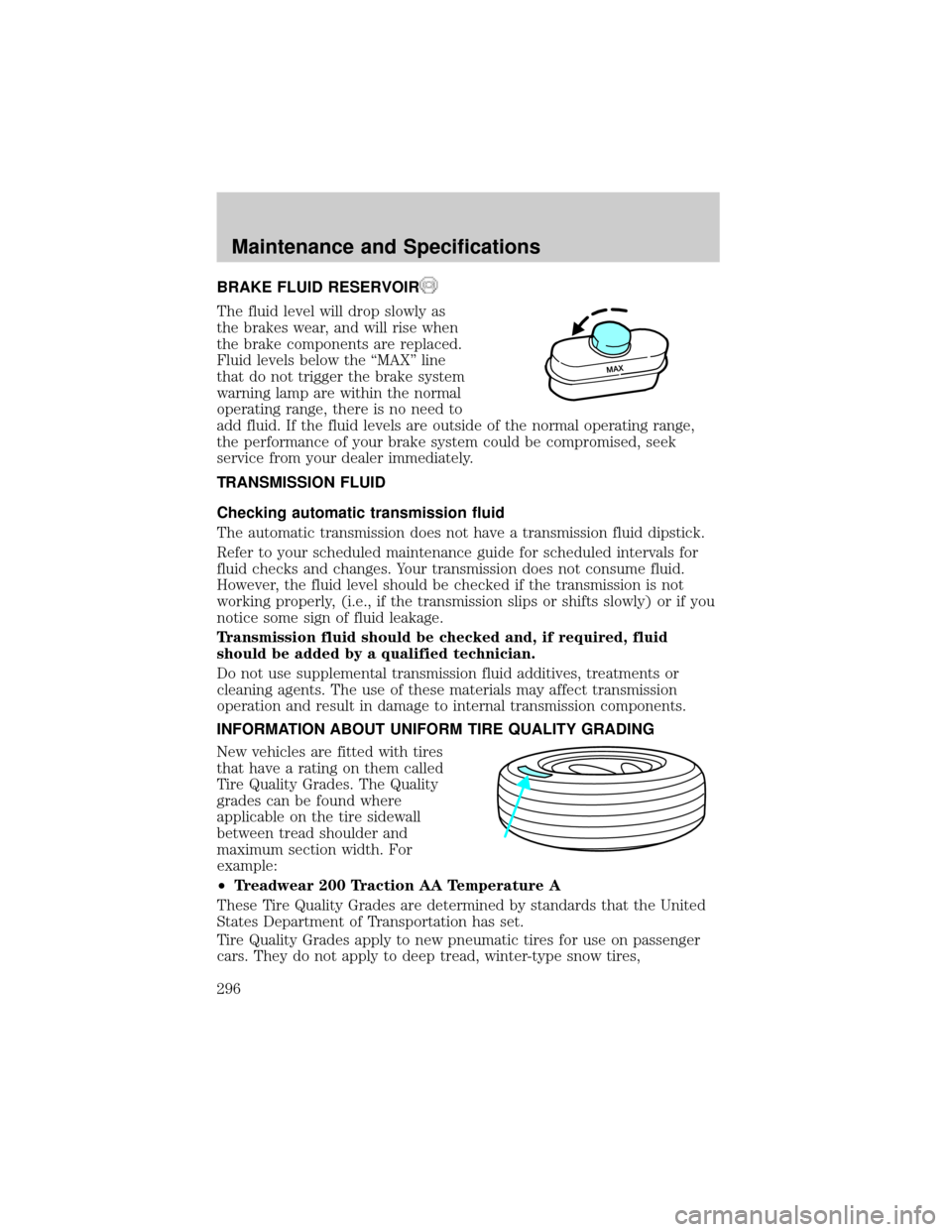
BRAKE FLUID RESERVOIR
The fluid level will drop slowly as
the brakes wear, and will rise when
the brake components are replaced.
Fluid levels below the ªMAXº line
that do not trigger the brake system
warning lamp are within the normal
operating range, there is no need to
add fluid. If the fluid levels are outside of the normal operating range,
the performance of your brake system could be compromised, seek
service from your dealer immediately.
TRANSMISSION FLUID
Checking automatic transmission fluid
The automatic transmission does not have a transmission fluid dipstick.
Refer to your scheduled maintenance guide for scheduled intervals for
fluid checks and changes. Your transmission does not consume fluid.
However, the fluid level should be checked if the transmission is not
working properly, (i.e., if the transmission slips or shifts slowly) or if you
notice some sign of fluid leakage.
Transmission fluid should be checked and, if required, fluid
should be added by a qualified technician.
Do not use supplemental transmission fluid additives, treatments or
cleaning agents. The use of these materials may affect transmission
operation and result in damage to internal transmission components.
INFORMATION ABOUT UNIFORM TIRE QUALITY GRADING
New vehicles are fitted with tires
that have a rating on them called
Tire Quality Grades. The Quality
grades can be found where
applicable on the tire sidewall
between tread shoulder and
maximum section width. For
example:
²Treadwear 200 Traction AA Temperature A
These Tire Quality Grades are determined by standards that the United
States Department of Transportation has set.
Tire Quality Grades apply to new pneumatic tires for use on passenger
cars. They do not apply to deep tread, winter-type snow tires,
Maintenance and Specifications
296
Page 313 of 336
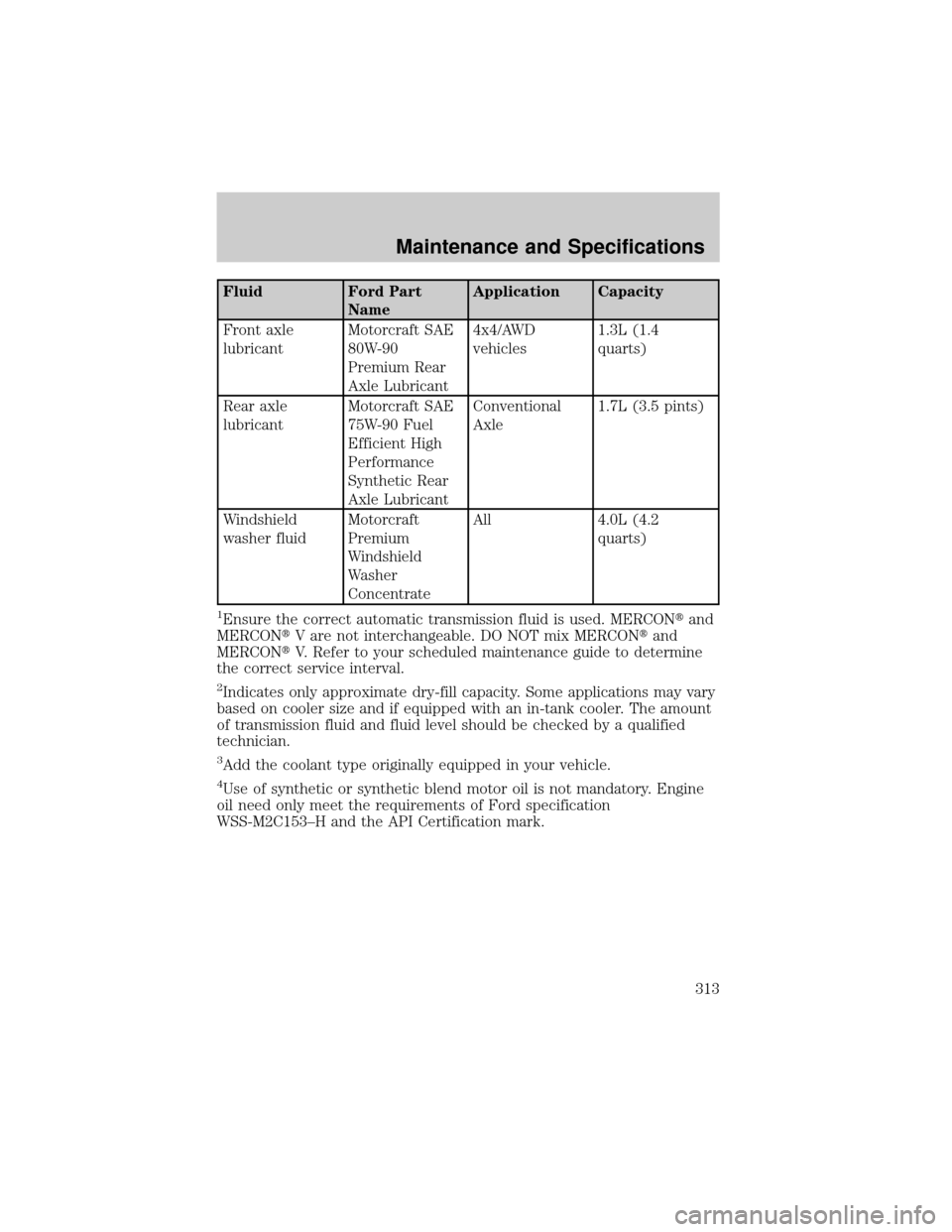
Fluid Ford Part
NameApplication Capacity
Front axle
lubricantMotorcraft SAE
80W-90
Premium Rear
Axle Lubricant4x4/AWD
vehicles1.3L (1.4
quarts)
Rear axle
lubricantMotorcraft SAE
75W-90 Fuel
Efficient High
Performance
Synthetic Rear
Axle LubricantConventional
Axle1.7L (3.5 pints)
Windshield
washer fluidMotorcraft
Premium
Windshield
Washer
ConcentrateAll 4.0L (4.2
quarts)
1Ensure the correct automatic transmission fluid is used. MERCONtand
MERCONtV are not interchangeable. DO NOT mix MERCONtand
MERCONtV. Refer to your scheduled maintenance guide to determine
the correct service interval.
2Indicates only approximate dry-fill capacity. Some applications may vary
based on cooler size and if equipped with an in-tank cooler. The amount
of transmission fluid and fluid level should be checked by a qualified
technician.
3Add the coolant type originally equipped in your vehicle.
4Use of synthetic or synthetic blend motor oil is not mandatory. Engine
oil need only meet the requirements of Ford specification
WSS-M2C153±H and the API Certification mark.
Maintenance and Specifications
313
Page 324 of 336

A
ABS (see Brakes) .....................197
Accessory delay ........................105
AdvanceTrac ..............................199
Air bag supplemental restraint
system ................................174, 178
and child safety seats ............176
description ......................174, 178
disposal ....................................181
driver air bag ..................176, 179
indicator light .........................180
operation .........................176, 179
passenger air bag ...........176, 179
side air bag ..............................178
Air cleaner filter .......................311
All Wheel Drive (AWD),
driving off road .........................211
Ambulance packages ....................7
Antifreeze
(see Engine coolant) ................281
Anti-lock brake system
(see Brakes) ......................197±198
Anti-theft system ......................149
arming the system ..................150
disarming a triggered
system .....................................151
Audio system (see Radio) ...16, 21
Automatic transmission
driving an automatic
overdrive .................................206
fluid, adding ............................296
fluid, checking ........................296
fluid, refill capacities ..............312
fluid, specification ..................316
Auxiliary power point ...............101
Axle
lubricant specifications ..314, 316refill capacities ........................312
B
Battery .......................................279
acid, treating emergencies .....279
jumping a disabled battery ....251
maintenance-free ....................279
replacement, specifications ...311
servicing ..................................279
BeltMinder .................................170
Brakes ........................................196
anti-lock ...........................197±198
anti-lock brake system (ABS)
warning light ...........................198
fluid, checking and adding ....296
fluid, refill capacities ..............312
fluid, specifications .........314, 316
lubricant specifications ..314, 316
parking ....................................198
shift interlock ..........................204
Bulbs ............................................88
C
Calculating load ........................224
Capacities for refilling fluids ....312
Cargo cover ...............................135
Cassette tape player ...................21
CD-single premium .....................16
Cell phone use ..........................131
Certification Label ....................318
Changing a tire .........................243
Child safety restraints ..............182
child safety belts ....................182
Child safety seats ......................184
attaching with tether straps ..188
in front seat ............................186
in rear seat ..............................186
Index
Index
324
Page 325 of 336

Cleaning your vehicle
engine compartment ..............267
instrument panel ....................269
interior .............................269±270
interior trim ............................270
plastic parts ............................268
washing ....................................266
waxing .....................................266
wheels ......................................267
wiper blades ............................268
Clock ..........................................101
Compass, electronic
set zone adjustment ...............120
Console ......................................132
overhead ....................................99
rear ..........................................132
Controls
power seat ...............................154
steering column ......................111
Coolant
checking and adding ..............281
refill capacities ................283, 312
specifications ..................314, 316
Cruise control
(see Speed control) ..................109
Customer Assistance ................231
Ford accessories for your
vehicle .....................................271
Ford Extended Service
Plan ..........................................259
Getting assistance outside the
U.S. and Canada .....................263
Getting roadside assistance ...231
Getting the service you
need .........................................257
Ordering additional owner's
literature .................................264
The Dispute Settlement
Board .......................................259Utilizing the
Mediation/Arbitration
Program ...................................262
D
Daytime running lamps
(see Lamps) ................................84
Defrost
rear window ..............................81
Dipstick
automatic transmission
fluid ..........................................296
engine oil .................................276
Doors
lubricant specifications ..........314
Driving under special
conditions ..........................214, 217
sand .........................................216
snow and ice ...........................218
through water .................216, 221
E
Electronic message center .......118
Emergencies, roadside
jump-starting ..........................251
Emission control system ..........292
Engine ........................................316
cleaning ...................................267
coolant .....................................281
fail-safe coolant ......................284
idle speed control ...................279
lubrication
specifications ..................314, 316
refill capacities ........................312
service points ..........................274
starting after a collision .........232
Engine block heater .................196
Engine oil ..................................276
Index
325
Page 327 of 336

Infant seats
(see Safety seats) .....................184
Inspection/maintenance (I/M)
testing ........................................294
Instrument panel
cleaning ...................................269
cluster ........................................10
lighting up panel and interior .85
J
Jack ....................................243, 245
positioning .......................243, 247
storage .............................243, 245
Jump-starting your vehicle ......251
K
Keyless entry system
locking and unlocking doors ..145
programming entry code .......143
Keys ...................................146±148
positions of the ignition .........193
L
Lamps
autolamp system .......................82
bulb replacement
specifications chart ..................88
daytime running light ...............84
fog lamps ...................................82
headlamps .................................82
headlamps, flash to pass ..........85
instrument panel, dimming .....85
interior lamps .....................87, 89
replacing
bulbs ..................88, 90, 92, 94±95
Lane change indicator
(see Turn signal) ........................87
Liftgate ..............................133, 139Lights, warning and indicator ....10
anti-lock brakes (ABS) ..........198
Load limits .................................221
Loading instructions .................224
Locks
childproof ................................137
doors ........................................136
Lubricant specifications ...314, 316
Luggage rack .............................134
Lumbar support, seats .............153
M
Manual transmission
fluid capacities ........................312
lubricant specifications ..........316
Message center .................118±119
english/metric button .............123
system check button ..............123
warning messages ...................126
Mirrors .................................99, 105
automatic dimming rearview
mirror ......................................105
fold away .................................107
heated ......................................107
programmable memory ..........139
side view mirrors (power) ....106,
108
Moon roof ..................................100
Motorcraft parts ................289, 311
N
Navigation system .......................26
cd functions ..............................42
destination mode ......................55
DVD location .............................77
map mode .................................46
quick start .................................28
Index
327